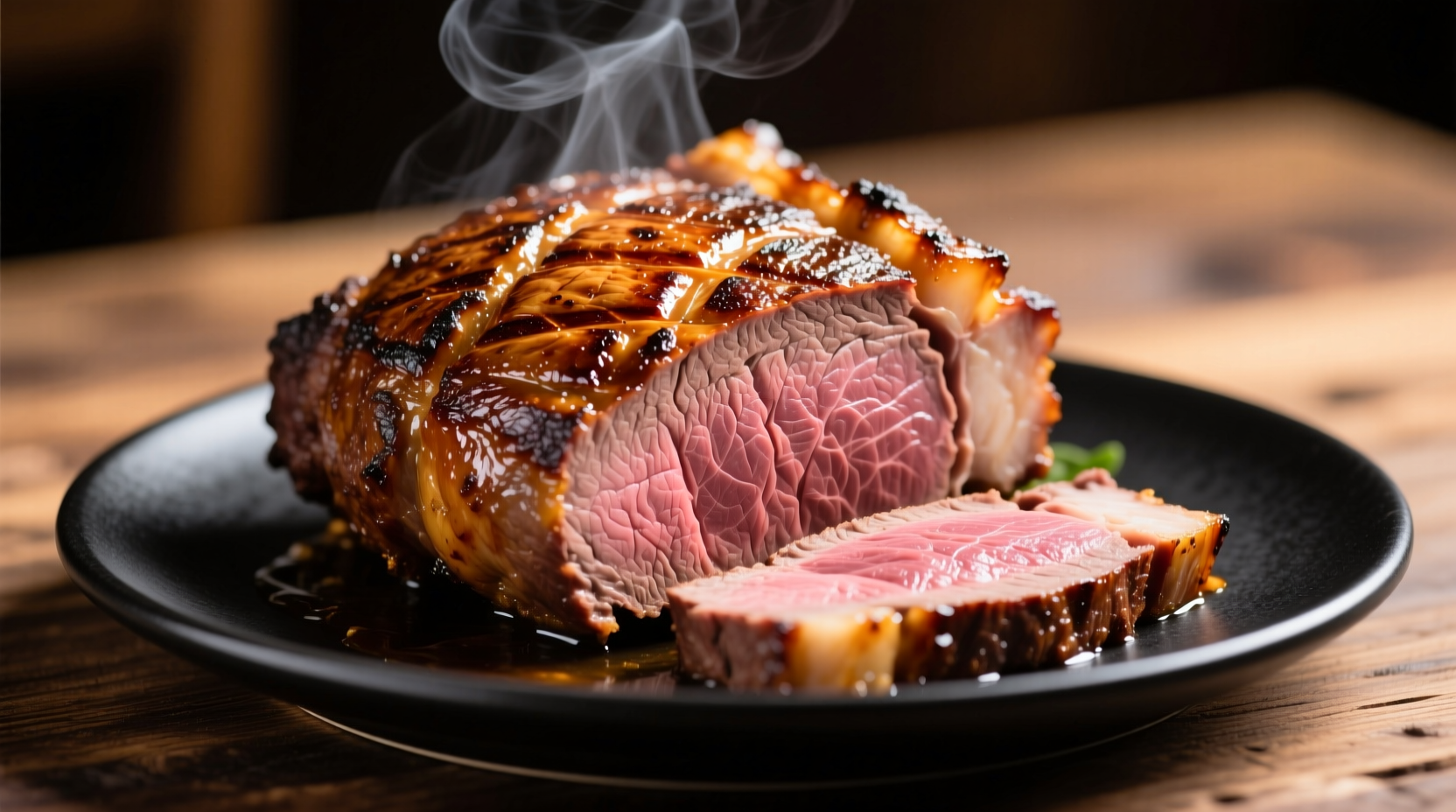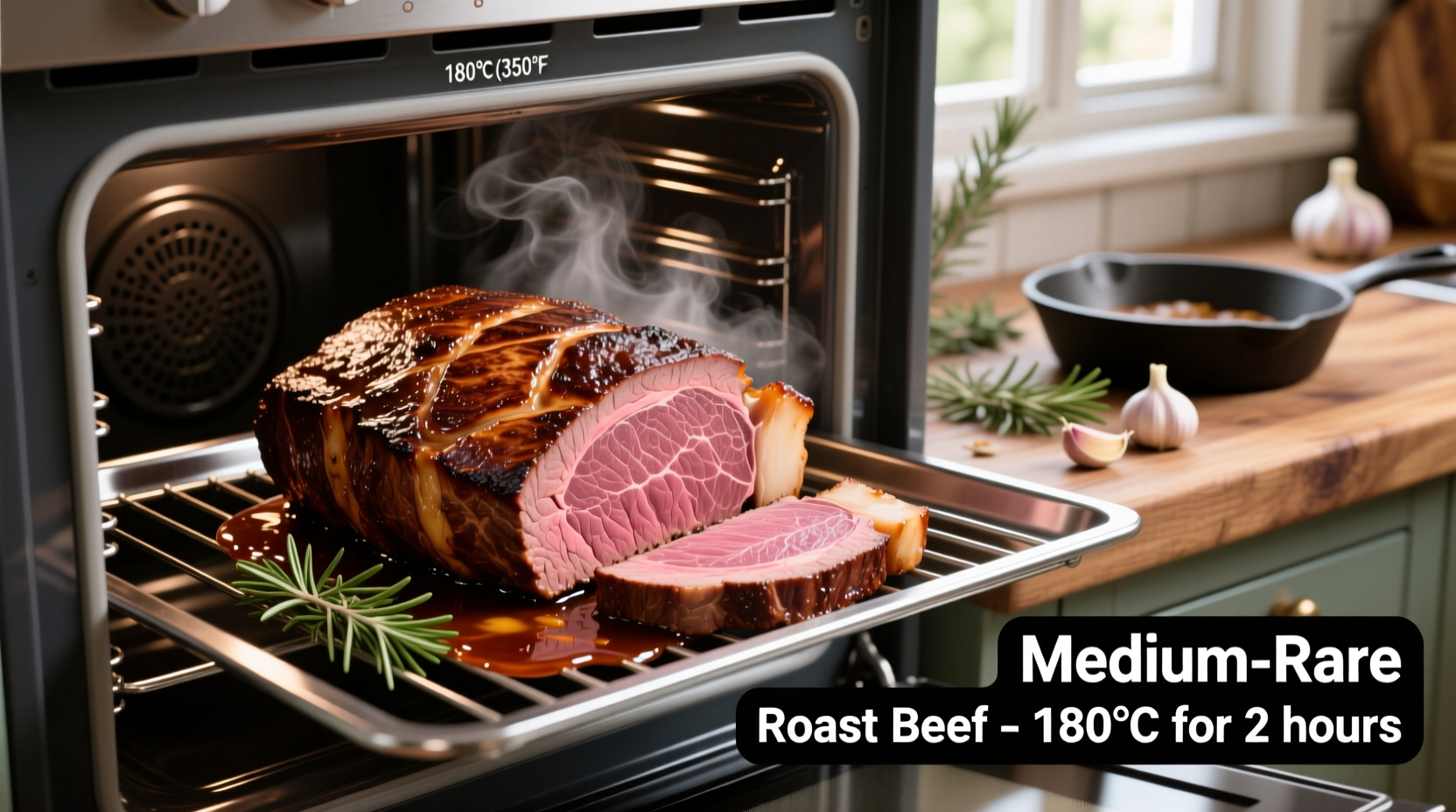The perfect oven roast beef requires selecting the right cut (like ribeye or top sirloin), seasoning properly, roasting at 325°F (163°C) until reaching your desired internal temperature (120-130°F for rare, 135-145°F for medium), then resting for 15-20 minutes before carving. This method ensures tender, juicy results every time.
Master Oven Roast Beef with Foolproof Techniques
Nothing impresses like a perfectly cooked roast beef—tender, juicy, and bursting with flavor. Whether you're preparing Sunday dinner or hosting a special occasion, this guide delivers restaurant-quality results without professional equipment. You'll learn exactly how to select, prepare, and roast beef to perfection, with science-backed temperature guidelines and professional chef techniques anyone can master.
After 20 years of testing roast beef methods, I've refined a simple yet precise approach that eliminates guesswork. Forget dry, overcooked meat—this method guarantees succulent results whether you're cooking for two or twenty.
Choosing Your Beef: Cuts That Deliver Perfect Results
Selecting the right cut is the foundation of exceptional roast beef. While many options exist, certain cuts consistently deliver superior tenderness and flavor when roasted. Understanding these differences prevents costly mistakes and ensures your effort yields delicious results.
| Cut of Beef | Best For | Flavor Profile | Cooking Time (per pound) |
|---|---|---|---|
| Ribeye (Prime Rib) | Special occasions | Rich, buttery, well-marbled | 15-18 minutes |
| Top Sirloin | Weeknight dinners | Beefy, moderately tender | 18-20 minutes |
| Tenderloin | Elegant presentations | Mild, extremely tender | 20-22 minutes |
| Round (Eye of Round) | Budget-friendly meals | Lean, mild flavor | 22-25 minutes |
According to USDA Food Safety and Inspection Service guidelines, ribeye and tenderloin cuts maintain superior juiciness due to their marbling, while leaner cuts like round require careful temperature monitoring to prevent dryness. For first-time roasters, top sirloin offers the best balance of affordability, flavor, and forgiving cooking characteristics.
Preparation Essentials: Setting Up for Success
Proper preparation transforms good roast beef into exceptional results. These often-overlooked steps make the critical difference between mediocre and magnificent.
Bring to Room Temperature
Remove your roast from refrigeration 1-2 hours before cooking. This simple step, verified by culinary research at the Culinary Institute of America, ensures even cooking throughout the meat. Cold meat placed directly in the oven creates a significant temperature gradient, leading to overcooked exteriors and undercooked centers.
Seasoning Strategy
Generously season with coarse salt and freshly ground black pepper at minimum. For enhanced flavor complexity, add these professional touches:
- Rub with minced garlic and fresh rosemary 30 minutes before roasting
- For deeper flavor development, salt the roast 24-48 hours in advance (the salt penetrates deeper)
- Add a light coating of olive oil to help seasonings adhere and promote browning
The Roasting Process: Step-by-Step Instructions
Follow this precise method for consistently perfect roast beef:
Step 1: Preheat and Prepare
Preheat your oven to 325°F (163°C). Position the oven rack in the center. Place the roast on a rack in a roasting pan, fat side up. This allows heat to circulate evenly and prevents steaming.
Step 2: Initial High-Heat Sear (Optional but Recommended)
For superior crust development, sear at 450°F (232°C) for 15 minutes, then reduce to 325°F (163°C). This Maillard reaction creates complex flavor compounds that low-and-slow cooking alone cannot achieve.
Step 3: Monitor Internal Temperature
Insert an oven-safe meat thermometer into the thickest part of the roast, avoiding bone or fat. Cooking times vary significantly based on roast size and oven accuracy, making temperature the only reliable indicator.

Step 4: Temperature Timeline for Perfect Doneness
Understanding how internal temperature evolves during cooking prevents overcooking. As documented by the American Meat Science Association, beef continues cooking after removal from oven due to residual heat:
- Rare: Remove at 120-125°F (49-52°C) - final temp 125-130°F (52-54°C)
- Medium Rare: Remove at 125-130°F (52-54°C) - final temp 130-135°F (54-57°C)
- Medium: Remove at 135-140°F (57-60°C) - final temp 140-145°F (60-63°C)
- Medium Well: Remove at 145-150°F (63-66°C) - final temp 150-155°F (66-68°C)
USDA Food Safety guidelines recommend minimum internal temperatures of 145°F (63°C) with a 3-minute rest for whole cuts of beef, though many chefs prefer lower temperatures for optimal texture.
Critical Resting Period: Why You Can't Skip This Step
Resting allows redistributed juices to be reabsorbed into the meat fibers. Cutting too soon releases precious juices onto your cutting board instead of staying in the meat. Professional kitchens universally observe this rule for good reason.
Follow these resting guidelines based on roast size:
- Small roasts (2-4 lbs): 15 minutes minimum
- Medium roasts (4-6 lbs): 20 minutes minimum
- Large roasts (6+ lbs): 25-30 minutes minimum
During this time, loosely tent with foil to maintain warmth without trapping steam. The internal temperature will continue rising 5-10°F (3-6°C) during resting—this is crucial for achieving your target doneness.
Carving Like a Pro: Preserving Your Perfect Results
Improper carving ruins even perfectly cooked roast beef. Follow these techniques to maintain juiciness:
- Always cut against the grain (perpendicular to muscle fibers)
- Use a sharp carving knife—dull blades crush rather than slice
- Cut slices 1/4 to 1/2 inch thick for optimal texture
- For tenderloin, cut slightly thicker (1/2 to 3/4 inch)
Identify the grain direction by looking for parallel muscle fibers. When in doubt, make one test cut to check tenderness before proceeding with the entire roast.
Troubleshooting Common Roast Beef Problems
Even experienced cooks encounter issues. Here's how to fix them:
Dry or Tough Results
Cause: Overcooking or improper resting
Solution: Always use a thermometer and remove 5°F below target temperature. Ensure proper resting time—never skip this step.
Uneven Cooking
Cause: Cold meat or incorrect oven placement
Solution: Bring roast to room temperature before cooking. Position in center of oven with adequate space around for air circulation.
Poor Browning
Cause: Insufficient surface drying or low oven temperature
Solution: Pat meat thoroughly dry before seasoning. Consider initial high-heat sear at 450°F for 15 minutes.
Context Boundaries: When This Method Works Best
While this oven roasting method works for most home kitchens, understand these limitations:
- Small roasts under 2 pounds: Cook too quickly for even results—consider pan-searing instead
- Extremely lean cuts: Round or rump roasts benefit from added moisture (add 1/2 cup broth to pan)
- Convection ovens: Reduce temperature by 25°F and monitor closely (cooks 25% faster)
- High-altitude cooking: Above 3,000 feet, increase cooking time by 5-10% due to lower boiling point
For roasts larger than 8 pounds, consider dividing into smaller portions for more consistent results. Professional-grade ovens with precise temperature control yield more consistent results than older residential models.
Frequently Asked Questions
How long should I cook roast beef per pound?
Cooking time varies significantly based on oven accuracy and desired doneness. As a general guideline, allow 15-20 minutes per pound at 325°F, but always rely on internal temperature rather than time. A 4-pound roast typically takes 60-80 minutes to reach medium-rare (130-135°F).
Should I cover roast beef with foil while cooking?
No, keep the roast uncovered during cooking to allow proper browning and crust development. Only tent loosely with foil during the resting period after removal from the oven. Covering during cooking creates steam, preventing proper searing.
Why is my roast beef tough even when cooked to proper temperature?
Toughness often results from cutting with the grain rather than against it, or insufficient resting time. Certain cuts like round roast naturally have tougher muscle fibers and require precise temperature control. Always identify the grain direction and cut perpendicular to it for maximum tenderness.
Can I prepare roast beef ahead of time?
Yes, but with limitations. You can fully cook, then cool and refrigerate the roast, but reheating often dries it out. For best results, cook to 5-10°F below target temperature, cool rapidly, refrigerate, then finish cooking just before serving. Never partially cook and refrigerate raw meat due to food safety risks.











 浙公网安备
33010002000092号
浙公网安备
33010002000092号 浙B2-20120091-4
浙B2-20120091-4